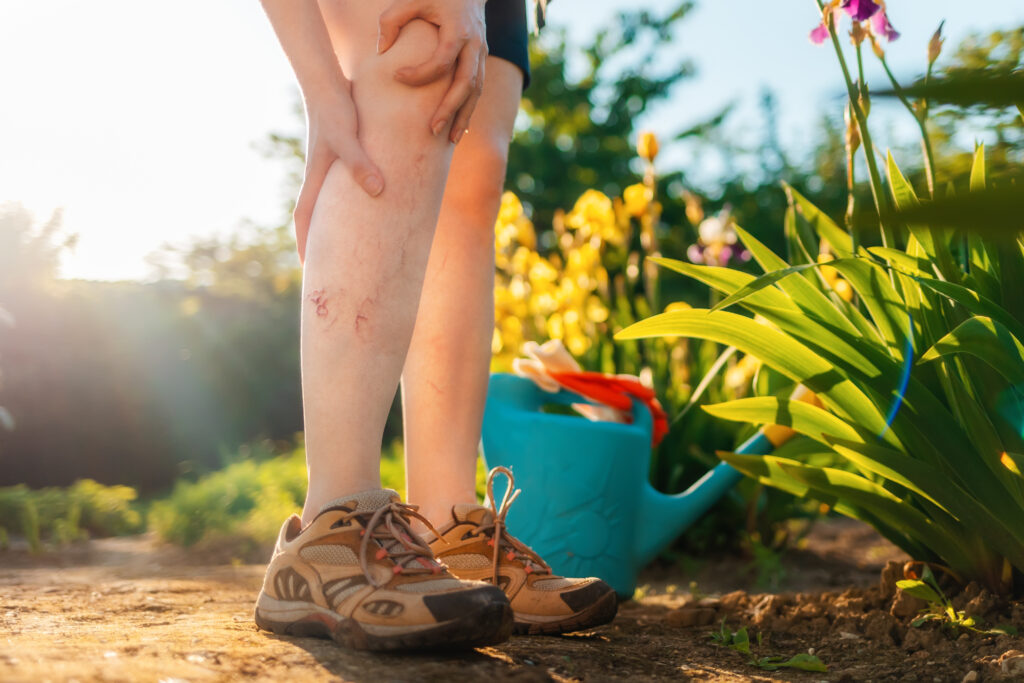By Kathy Abascal
Do your ankles sometimes swell? Do you have varicose veins or hemorrhoids? Personal questions, but important ones. Because, if you do, you could end up with chronic venous insufficiency, or CVI.
I am sure you know that the heart pumps blood out to the hands and feet. But have you ever wondered how the blood manages to get back to your heart? There are no pumps in your feet moving the blood back “uphill.” Our circulation relies on the mechanical squeezing that comes from moving your calves and thighs. This, along with valves in the veins that (if working properly) prevent the blood from flowing back downwards as the muscles move it up the leg, squeeze by squeeze.
Unfortunately, this system malfunctions in many people. As the return circulation becomes sluggish, blood pools and proteins leak out of the capillaries. Water follows to dilute the protein, leading to swelling of the extremities. This is an inflammatory condition that slows the delivery of nutrients to, and the removal of waste products from, the swollen area.
No one really knows what causes CVI, but we do know that too few flavonoids in the diet, inflammatory foods (sugars, white flour, chemicals, bad fats, etc.), too much standing and sitting, combined with too little walking and exercise increase your chances of joining the 15 to 35% of Americans who suffer from CVI.
People with CVI usually end up with varicose veins, swelling of the ankles and legs, and leg pain. The swelling usually begins around the ankles and moves up the leg as the condition worsens. The legs feel heavy or achy; these symptoms often occur after the person has been standing for a while. If both the superficial and deep veins are involved, intense leg cramping can occur. In the later stages of CVI, slow-healing leg and foot sores may appear.
Western medicine usually treats CVI with compression stockings. These stockings reduce the swelling, but most people find them so uncomfortable that they end up not wearing them. In Europe, some doctors prescribe herbs along with compression stockings. Most of these herbs are rich in interesting flavonoids that prevent capillary leakage. Their mechanisms of action vary, but all improve venous tone, venous blood flow, capillary permeability, and lymphatic drainage.
Ruscus aculeatus (butcher’s broom) is one of my favorites for CVI. This prickly little shrub could easily be cultivated in many parts of the United States, but so far is not. At one time, butchers used its branches to clean meat stalls and keep flies at bay, which is how the plant ended up called butcher’s broom.
Many studies show that butcher’s broom improves the symptoms of CVI. In one, 82% of treating physicians found it to be excellent for CVI. The remaining 18% thought it was a good treatment! In addition to helping reduce lower leg swelling, butcher’s broom is a good treatment for hemorrhoids, minor sprains and bruising, as well as PMS water retention. It is my first choice to prevent CVI from developing in clients showing symptoms of poor circulation in the lower legs.
Aesculus hippocastanum (horse chestnut) seed is another good herb for CVI. This medicine grows on a beautiful tree that has been planted in many places on the Island. While its fruits make good medicine, they are not edible. In Germany, horse chestnut is the most widely used botanical for venous edema; it helps with heaviness, nocturnal leg cramping, and leg itching and swelling. And, believe it or not, a Western scientific study found it to be an effective and safe short-term treatment for CVI.
The only drawback to butcher’s broom and horse chestnut is that they are far more useful in the early stages of CVI than later in the game.
Oligomeric proanthocyanidins, or OPCs, are also useful supplements in CVI. OPCs are found in the bark of some trees, in some seeds, and in most berries. OPCs are primarily known for their antioxidant activity, but they also quiet inflammation and prevent excessive platelet aggregation and capillary permeability.
The best-studied OPC is pycnogenol, which is extracted from a particular species of pine bark. Unlike butcher’s broom and horse chestnut, it seems to work well, even in severe cases and advanced stages of CVI. At the other end of the spectrum (in those who have not developed any signs of CVI), OPCs may also help prevent clotting during airplane flights. The initial studies, though small, look good, so I think it makes sense to take some pycnogenol a few days before, during, and a few days after a flight – to help your circulatory system cope with the pressure changes that come with flying.
Almost all berries contain OPCs, although they are not identical to pine’s pycnogenol. Still, they are very good for your veins and capillaries. All fruits and vegetables have flavonoids that strengthen the circulatory system. I suspect you know where this is heading. If you have, or are likely to get, CVI you should eat as many colorful vegetables and berries as you possibly can. You should walk often and avoid sitting or standing still for long periods of time. Finally, you might want to add butcher’s broom and/or horse chestnuts to help protect and repair your capillaries and veins, and maybe add some pycnogenol if your veins have been troubled for some time.

